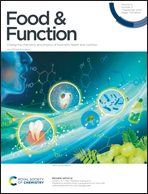Effects of enzymatic modification on the stability of cashew-based milk†
Abstract
The green and low-carbon awareness drives the consumption demand for “clean-label” plant-based milk, which is limited by its physicochemical stability. Herein, the effects of enzymatic hydrolysis on the stability of cashew-based milk (CM) are explored in detail. Our results showed that a maximum protein solubility of 41.36 ± 2.14% was achieved under bromelain treatment of CM either for 60 min or with the addition of 600 U g−1. Under these hydrolysis conditions, CM showed smaller particle size, larger zeta potential, and more uniform size distribution in comparison with the control. Similar behavior was also observed in the apparent viscosity and macroscopic stability, demonstrating the fortification of moderate hydrolysis on the physical stability of CM. Interestingly, bromelain hydrolysis could favor improving the oxidative stability of CM, for which the peroxide value and thiobarbituric acid reactive substances were decreased by 90% and 60%, respectively, after 14 days of storage in comparison with the control. The correlation analysis confirmed that the physical and oxidative stability was highly associated with protein solubility and secondary structures like α-helix. Therefore, our findings could provide scientific support for developing plant-based milk with fortified physicochemical stability.



 Please wait while we load your content...
Please wait while we load your content...